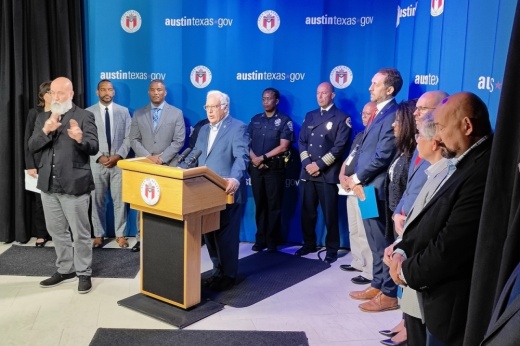“Everybody that’s paying attention to this and watching: Do what we need to do to try to stay cool, and do what we need to do to conserve our energy and conserve our water," Mayor Kirk Watson said during a June 4 press conference.
The outlook
Travis County Judge Andy Brown said, in addition to staying safe and cool themselves, residents should also watch out for their friends, family and neighbors—especially those who are older and more medically fragile.
Public city and county facilities, including libraries and community centers, will be available to serve as cooling centers for anyone in need during regular business hours. Maps and information on city facilities and county community centers are available online.
For Austinites experiencing homelessness, the city and nonprofit Urban Alchemy have space open seven days a week at downtown shelter facilities to visit for water or coffee, and to sign up for potential shelter opportunities. The Austin Resource Center for the Homeless, or ARCH, is also serving as a cooling center and has served hundreds of individuals this year.
Officials noted emergency calls have already been ticking upward on hot days this year, which they attributed both to the rising temperatures amid climate change as well as heightened community awareness about heat-related illness.
Ken Snipes, director of the Office of Homeland Security and Emergency Management, said 123 visits to Austin-area hospitals were reported due to heat in May alone—a more than 150% increase from May 2023. And Austin-Travis County EMS Chief Robert Luckritz said a "significant spike" in heat incidents took place around Memorial Day, with 54 reported over the holiday weekend this year versus eight last year.
Luckritz said residents should be aware of heat illness signs, and to quickly stop activity, hydrate and seek shade if any are being experienced.
Initial symptoms such as cramping and pale or clammy skin can progress to weakness, dizziness, heavy sweating, nausea and elevated pulse. Confusion, a lack of sweat or loss of consciousness can be the signs of "truly life threatening" heat stroke, he said.
"We want people to know to be safe and continue to take precautions as they engage throughout the summer in activities. ... When there are three or more days of heat over 100 degrees, there tends to be a spike in heat-related illnesses. We need our community to prepare for a long, hot summer," Snipes said.
The approach
At the state level, officials with the Electric Reliability Council of Texas remain confident in the state power grid amid high heats and say they'll be transparent about any requests for Texans to limit their power usage through the summer season.
Locally, Watson said Austin Energy has completed its summer weatherization processes, and the power utility will also communicate with customers if energy conservation is needed. Local power outages can be monitored and reported online or by texting "OUT" to 287846.
Watson said power-saving tips include limiting appliance use during the day, raising air conditioning settings by a few degrees and using fans for cooling.
While the Lower Colorado River Authority loosened watering restrictions given lowered drought conditions in the region, Austin remains at Stage 2 drought levels, and residents are limited to watering one day per week. Watson advised doing so at cooler times earlier in the morning or later in the evening.
“It’s important to understand our water supply has been stressed from years of drought, and we need to continue to use water wisely. So know your watering day just like you know your trash day," he said.
Also of note
Snipes said high temperatures typically don't have an impact on air travel systems. However, he advised travelers to stay tuned to weather forecasts for weather such as thunderstorms that can follow heat waves and have an effect on flight schedules.
More information on heat safety, wildfire preparedness and other emergency information is available online.





